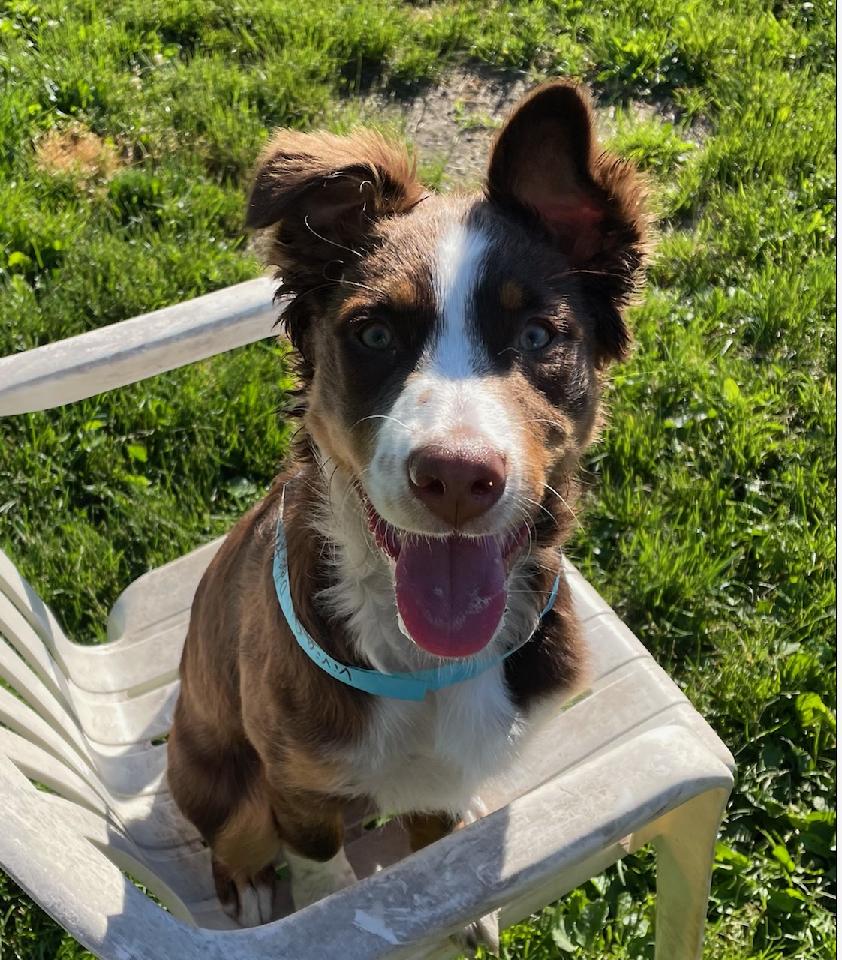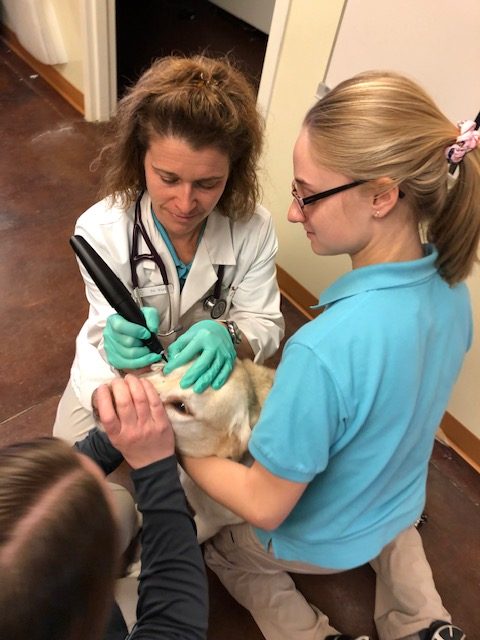Posts in Category: ZimmVet News & Events
Dog Parks
By Abby Gustafson, ZimmVet Receptionist
Did you just get a new dog? Well, congratulations! You probably want to take him/her to the nearby dog park now, right? Have you thought about this? Taking your new dog to a dog park, regardless if on or off leash, can be a bit rewarding as well as scary to pets and to you.
Let’s dig a little deeper into this. What are the benefits of a dog park? Well, for starters, your canine companion gets socialized with other dogs and humans. A tired dog is a happy dog. Your dog can learn from other dogs on how to play, interact, and possibly have fun.
On the other side, a dog park can carry diseases and parasites if dogs go that haven’t been dewormed or vaccinated. Other owners might not fully pay attention to their dog as it runs wild without notice.
Other dogs might not be friendly to other dogs – some dogs may not like others that are bigger or smaller than them.
It would be best for your dog to be trained to the recall or come command before heading to a dog park. Making sure your dog will come to you whenever you call it over, as well as making sure your dog is up to date on vaccines as well as a dewormer.
How to Teach a Cat to Fetch
By: Amy Johnson, CVT ZimmVet
Yes, you read that title correctly — cats can do the same things that dogs can do, and maybe even better. Discover how to teach a cat to fetch, and impress all of your neighbors and friends.
Think Like a Cat
Dogs love to please owners; however, cats are more concerned with pleasing themselves. By realizing this simple concept, you can understand why teaching a cat to fetch has to be approached differently from how you would train your dog. When it comes to training a cat, there are some basic techniques that you must know in order to be successful. These basic principles all start with the letter “R,” so that makes it a little easier to remember!

Respect
You need to respect what cats do and don’t like. Don’t stare at your cat or make loud noises during training or playtime. When they doesn’t feel up for play, don’t force it. Try to train them when they are feeling extra playful.
Reinforcement
Consistently recognize when your cat does things you want her to do, and be consistent in how you let your cat know she is doing things you don’t like (for instance, walking on your counters). A firm “no” or clap when she misbehaves may work, but when she does something you approve of, don’t give her a round of applause. Instead, pet her or give her a treat.
Rewards
Cats love small treats as a reward for good behavior. One of the secrets of how to teach a cat to fetch may be hidden in simply having the right treats. Use them only when she does the action you want her to, and don’t overdo it, so as to not add unwanted pounds.
Timing Is Everything
First, you have to get to know your cat, and build a trusting and loving relationship before you can start training them to do tricks or play fetch. Figure out what toys or items in your house they’re drawn to the most. These items are the ones you should try to use for playing fetch.
Cats are drawn to hunt and pounce on things — throwing a soft item and allowing your cat to chase it, and then going over and placing a treat near the item may reinforce and reward the first step in fetching. After a few days of successfully getting your cat to pounce or go near the item you throw, you are ready to attempt having them bring you the item. You can do this by leaving a trail of treats after throwing the item. As time goes on, make the treats closer to you and farther from the object. Keep in mind, it is best to do all of this at a time of day when your cat is most active. Make sure to always use the same verbal queues to reinforce the action such as “fetch,” or “bring it here.”
Fetching Failures
If it seems like all of your attempts at training your cat to fetch have failed, take a break for a few days and then try again with new toys and different treats. Not all dogs like the same games, so it is possible your cat won’t ever be interested in fetch. However, don’t give up too quickly. Allow several different people in your home to try to train her. Cats sometimes bond with one person more than another and may only want to play fetch with their favorite human.
If you are successful, be sure to catch it on video so that all of your friends believe you! Everyone loves fun cat videos.
How To Prepare For My Pet’s Surgery
By: Ashley Middendorf, CVT ZimmVet
- Presurgical exam: Each pet will come in for a presurgical exam prior to the day of surgery. This will allow the doctor to evaluate your pet as well as update any necessary lab work and vaccines that your pet needs.
- Schedule the surgery: The actual surgical appointment can be schedule over the phone or in person. Wait times vary depending on the procedure but the sooner you schedule the better.
- Consent form: The surgery consent form will be sent to you via email and be completed prior to the surgery day.
- Night before surgery day: No food after 10pm, but water is ok up until your pet is at the clinic
- Morning of surgery: You’ll be dropping off your pet with the surgery technician at a scheduled time usually between 7:30 am and 8:30 am.
- Surgery will be completed for your pet.
- After Surgery: You will be notified of you pets completion of surgery and how he or she is recovering.
- Discharge time: You will be scheduled a discharge time to pick up your pet and go over discharge instructions/medications with a certified veterinary technician.
- Recheck: Depending on what surgery your pet had you may need to bring he or she back for a recheck with the surgery doctor in a certain time frame.
Leptospirosis
By Keri Hesse, CVT ZimmVet
What is Leptospirosis?
Leptospirosis is a bacteria that is found in stagnant, slow moving water but can be found in the soil near or around where there had been stagnant water. The common carriers of Leptospirosis is wildlife which is the most common route of exposure to our pets. This disease is also zoonotic; meaning that our pets can transmit it to us.
How does our beloved pets become infected?
The bacteria is penetrated through the skin through a cut/abrasion from the contaminated water or the contaminated urine of wildlife, reproductive organs exposed to the bacteria, even the consumption of infected tissues can be the cause of Leptospirosis.
What happens if my pet gets Leptospirosis?
Once exposed to Leptospirosis, the bacteria is spread through the bloodstreams causing inflammation of the vessels, fever, abnormal bleeding, and bruising of tissues. By the time symptoms have started showing, Leptospirosis has set up in the kidneys, causing inflammation of the kidneys and can disrupt urine production, ultimately leading to kidney failure. Some strains of Leptospirosis can cause inflammation of the liver and ultimately causing liver damage or failure.
Is there treatment for leptospirosis?
If caught readily, Leptospirosis can be treated with hospitalization, IV and oral antibiotics, and IV fluids to help flush the bloodstream and kidneys of Leptospirosis. During this time, it is crucial to protect ourselves from the contaminated urine to prevent infecting ourselves.
Can I prevent my pets from getting Leptospirosis?
Leptospirosis can be prevented ultimately with a vaccine.The first vaccine is given and then boosters in 3-4 weeks and lasting a year. So, it is important to make sure your pet is vaccinated yearly for this bacteria.
Most common thought is that our dogs that are either hunting, camping or around our lakes are the most exposed pets. But, with the amount of wildlife that come into our backyards any dog could be exposed to these serious bacteria. This can all be prevented with a yearly vaccine, please vaccinate your dogs. If you have questions, reach out to one of our staff members for more information.
Environmental Enrichment for Cats
By Dr. Olson DVM at ZimmVet

Making a fun and playful home for your cat prevents destructive behaviors and obesity due to inactivity. Here are some ideas that you may be able to do in your home.
1. Cat Furniture – This allows them to exert their natural instinct to climb and romp around safely. There are several readymade cat trees and condos that range in prices. You can also build your own and they have several websites that help you make your own personalized towers if interested.
2. Scratching Posts – This not only gives them a way to express their desire to scratch, but also can save furniture and carpeting. Make sure the scratching post is in high traffic areas instead of a corner of the home that is infrequently used.
3. Window Perch – Set up a bed or shelf in front of a window for your cat to watch everything happening outside. Make it even more special by placing a bird house or feeder near the window. You can purchase window shelves or just place a piece of furniture to allow access to view outside.
4. Wheat Grass – Grow wheat grass for your cat to chomp on. Several places sell specific grass for your cat, but there are also online kits that you can do yourself.
5. Foraging Toys – These are toys that make your cat manipulate it some way to obtain the food reward. There are several products available or you can simply make your own using plastic house hold containers or small cardboard box with holes (slightly larger than the treat) cut out of them. These toys require them to use their hunting skills to get the treat out.
6. Vertical Spaces – Similar to the free-standing condos, wall steps allow your cat to move around the home without having to touch the ground. Cat are more relaxed in high vertical spaces. There are several websites that sell premade products, but you can also make your own (again there are several DIY sites to help).
7. Water Fun – You can place a small windup toy in a sink filled with water. Any item that floats like a ping pong ball does well also. You can find some special cat products available, but you can also look in the infant bath section of a toy or department store.
8. Nature Videos/Music – Some cats love watching television, especially if geared towards them. Cats are attracted to nature and wildlife sounds. Leaving the tv on the Animal Plant or similar program may entertain your cat during the day. There are also videos produced for cats specific that you can purchase.
9. Outdoor Enclosures – Even indoor cats can enjoy the outdoors safely. There are screened in window enclosures, full “catios” or other enclosures that your cat can enjoy the outdoors safely.
10. The Old Standby – even supplying a simple cardboard box or paper bag for the cat to explore and hide in will give them much joy.
With all these suggestions it is always most important that it is safe for your cat!
Make sure that they are not able to eat small pieces, get entrapped (handles on bags, etc.) or have sharp edges/nails to cut themselves on.
Trimming Pet Nails
By: Abbey Stackhouse, Assistant at ZimmVet

Nail trims on your dog or cat can seem like a scary task at first, but there are plenty of things that could make the experience better for you and your pet. The first step is knowing how to trim their nails in the first place.
Start by getting a pet nail trimmer. There are different size trimmers depending on your pet size. Cats have thin nails so a human nail trimmer can be used for cats. Make sure you keep the blade sharp, as it makes it the easiest and most painless way to trim their nails.
Second, start slowly and pull their legs closely to you so you can feel and see their nail clearly. Start with one paw at a time, trimming one nail at a time. The key to this is looking at the nail and determining where you should first cut it. The nail has something called a ‘quick’ in it, this is what supplies the blood to the nail. You want to make sure you aren’t cutting it too short and hitting that quick when trimming. There are many helpful diagrams on the internet that can show you better where you should be trimming.
Lastly, cut the nail quickly and smoothly and move on to the next nail. It is a lot easier to trim your pet’s nails when there is some sort of distraction. My personal favorite is swiping some peanut butter on my dog’s nose, or some spray cheese on a cat’s nose to take their mind off of the nail trim for a few seconds. I also like using a Kong or some type of treat toy as a distraction as well when trimming nails. When you are done trimming the nails on all four paws, give your pet a nice treat and a ton of praise to make them feel good and hopefully make it easier the next time you have to trim their nails. If you need help learning how to safely trim nails make an appointment at your veterinarian.
How to Clean Pet’s Ears
Angie Novatney, CVT ZimmVet

Cleaning your pet’s ears can be a challenging task but, there are a few ways to make it easier for you and your pet. First, there are supplies you’re going to need. You’ll need an ear cleaning solution designed specifically for animals, some cotton balls, and cotton swabs too. It helps to have someone assist in holding and distract your pet with some treats too! Peanut butter or canned spray cheese is a very helpful treat because this can distract your pet and is something they can lick at slowly. There are two ways to apply the ear cleaner, either pouring a small amount into the ear or applying to the cotton balls and wiping out the ears. If you pour the ear cleaner into the ear, you need to massage the base of the ear to move around the cleaner to loosen any debris within the ear. Wipe out gently with cotton balls to get the majority of the debris, then cotton swabs can be used within the crevices of the ear to get the smaller debris. Make sure not to go down too deep into the ear canal with cotton swabs as this can cause damage to the ear drum. It is good to allow your pet to shake their head during the cleaning to dislodge any debris farther down the ear to come out easier, then it can be wiped out. You can repeat this process of ear cleaner and wiping out a few times until all debris is gone from the ear. Make sure to clean ears after bathing, playing in the sprinkler or swimming, or even in the winter after playing in the snow. Ear cleaning can be done weekly to monthly depending on the amount of debris you see in the ears. If the ears are cleaned too frequently this can irritate the ears and problems.
Pet Encounters with Wildlife
By Dr. Leslie Reed, ZimmVet – 763-856-4848

Tis the season for an abundance of wildlife as mammals emerge from hibernation, bird migration is underway, and baby animals are being born left and right. So, what to do if your dog or cat comes into contact with an adult or baby wild animal? Below are some common scenarios you may find yourself in. Follow these basic guidelines and please always check in with a local wildlife rehabilitation center if you find any injured, sick or truly orphaned wild animals.
Q: My dog found a nest of baby bunnies and I’m worried he will hurt them. What should I do to keep the babies safe?
A: Mama rabbits only come to the nest twice per day to feed her young, typically at dawn and dusk. She feeds them a very high fat milk very quickly, typically over 10-15 minutes, then will leave the nest. The reason she does this is to avoid attracting predators. If you find a nest of baby bunnies (typically a shallow depression in the ground), leave them be. If the nest has been disrupted or destroyed, you can recreate it with leaves, grass, and any rabbit fur that is still present. To keep curious pups away, either keep them on a leash when outside or flip a laundry basket upside down and over top of the nest to provide a cover and stake it down for the day. Remove it just before dusk and leave it off overnight to allow mom to come feed. Thankfully, baby rabbits mature quickly and will be out of the nest at 3-4 weeks of age.
Q: My cat brought me a live baby bird/rabbit/chipmunk/etc – what do I do?
A: Any wild animal that has been in a cat’s mouth should be evaluated at a wildlife rehabilitation center. Not only could they have injuries that need to be addressed, but cats have bacteria in their mouth that can be fatal to wild animals.
Q: Can my cat or dog catch diseases from wild animals?
A: Yes! Wildlife can transmit many types of infectious diseases to domestic animals, including mange, distemper virus, leptospirosis, rabies, fleas, and internal parasites such as roundworms and tapeworms. It is very important that if your pet is in an area with high exposure to wildlife, that they are adequately protected with vaccines, routine deworming, and flea and tick prevention year-round.
Continue…Benefits of Cryotherapy
By Dr. Maria Krenz, DVM – ZimmVet-763-856-4848

Cryotherapy is a treatment that has been around for years in both the human medical field as well as veterinary care to treat masses, skin lesions, skid tags, eye tumors and more. In recent times, the technology has become more precise and easier to use in the veterinary industry.
What is Cryotherapy
Cryotherapy is a procedure that uses extreme cold to destroy tissue. The process is called cryo-necrosis, or tissue destruction by freezing. Cryotherapy freezing is set to -80 degrees Fahrenheit to destroy the cells. Nitrous oxide is the active ingredient used in cryotherapy, instead of liquid nitrogen, which is what most people are familiar with. Liquid nitrogen is not used because the temperature achieved is lower that nitrous oxide and results are not as precise. Modern day Cryotherapy tools with nitrous oxide look like a large pen and can apply the cooling effect very precisely.
Anesthesia-Free
One of the biggest benefits of Cryotherapy is that it can be used to remove small masses without the use of anesthesia or cutting of the skin. The cold temperatures apply a local numbing effect, which allows the pet to be treated with minimal discomfort. Cryotherapy can be used to treat a wide range of benign skin lesions on pets such as adenomas, skin tags and eyelid tumors. Another benefit is the cost of treatment is significantly lower as compared to surgical removal with anesthesia.
Continue…Tick Borne Disease- What you need to know
By: Dr. Soderberg, DVM ZimmVet

What tick borne disease is in my area?
Lyme disease (Borrelia burgdorferi ) is a bacteria transmitted primarily by the deer tick (tiny black legged tick) that can infect both dogs and people alike. Anaplasmosis (Anaplasma phagocytophilum) is a bacteria also transmitted through bites of the deer tick as well as the western black-legged tick and brown dog tick. Ehrlichiosis (Ehrlichia canis) is a tick-borne infectious disease of dogs, usually carried by the brown dog tick. The organism responsible for this disease is a rickettsial organism which is similar to bacteria.
How do I prevent tick borne disease?
Tick disease can be difficult to detect and can cause serious and recurring health problems if left undetected and untreated. Therefore, it is best to prevent infection by taking appropriate measures to prevent tick bites and, for dogs, vaccinating against lyme disease. Any time the temperature is above 35 degrees Fahrenheit ticks come out to feed. Every month of 2019 in Minnesota there was a day where the temperature was above 35 degrees which means our pets should be on tick preventative every month of the year! There are numerous topical and oral tick preventatives. Please discuss preventatives and the lyme vaccine with your veterinarian to determine the best products for your pet. Your veterinarian’s advice may depend on where you live, your pet’s lifestyle and overall health, and other factors.
What does tick disease look like in my pet?
Some pets will not have any or only minor symptoms when they are infected with a tick disease. Pets infected with Lyme disease may not show any signs for 2-5 months. After that time, typical symptoms include fever, loss of appetite, shifting leg lameness, joint swelling, and decreased activity. Infection with anaplasmosis causes very similar clinical signs as those listed above and usually last for 1 to 7 days. Infection with anaplasmosis can also cause reoccurring thrombocytopenia, a condition in which there is a periodic decrease in platelets (circulating cells that help in the blood clotting process). Clinical disease caused from thrombocytopenia is often mild, but some dogs may develop bruising or bleeding, especially during the early stages of infection when platelet counts may be at their lowest. Ehrlichiosis causes similar signs as anaplasmosis including thrombocytopenia which can last up to four weeks.
How do you diagnose tick borne disease?
Several types of tests to diagnose tick disease are available. Exposure to Anaplasma, Lyme, and Ehrlichia can be detected in your veterinary clinic using a special test kit. Other tests like quantitative titers, ELISA tests, and polymerase chain reaction (PCR)s are available to help your veterinarian determine if active infection is present. These tests are sent to an outside lab. It may also be difficult to diagnose infected dogs during the very early stages of infection as the immune system usually takes two to three weeks to respond to the presence of the organism and develop antibodies required for testing.
How do you treat tick borne disease?
The treatment for tick borne disease is fairly similar across the different infections and usually consists of a 2-4 week treatment with an antibiotic called doxycycline. In the majority of cases, symptoms improve rapidly and the prognosis for clinical recovery is excellent.
Because chronic tick borne disease has not been directly related to clinical disease and because a treatment effective in clearing the organism from an infected animal has not been established, treating clinically healthy, positive testing animals is of questionable benefit and not generally recommended at this time. However, a positive test result in a clinically healthy dog should not be disregarded. At a minimum, positive dogs should have an aggressive tick control program implemented to minimize exposure to ticks. It is clear that co-infection with two or more tick-borne agents is common and that dogs co-infected with multiple tick diseases are nearly two times more likely to develop clinical disease than dogs infected with either one alone.
Can I get tick disease from my pet?
Tick borne disease is not communicable from one animal to another, except through tick bites. However, if you have more than one pet and one is diagnosed with a tick disease, your veterinarian will recommend testing any other pets who may have been exposed to ticks at the same time.


